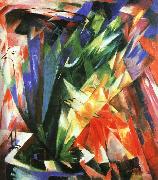Wholesale Oil Painting No Minimum |
|||||||||||
|
|
|||||||||||

|
|||||||||||
|
|
|
||||||||
Franz Marc1880-1916 German Franz Marc Locations Franz Marc was born in 1880, in the German town of Munich. His father, Wilhelm, was a professional landscape painter, and his mother Sophie was a strict Calvinist. He began study at the Academy of Fine Arts, Munich in 1900. In 1903 and 1907 he spent time in Paris and discovered a strong affinity for the work of Vincent van Gogh. Marc developed an important friendship with the artist August Macke in 1910. In 1911 he formed the Der Blaue Reiter artist circle with Macke, Wassily Kandinsky, and other artists who decided to split off from the Neue K??nstlervereinigung movement. He showed several of his works in the first Der Blaue Reiter exhibition at the Thannhauser Galleries in Munich between December 1911 and January 1912. The exhibition was the apex of the German expressionist movement and also showed in Berlin, Köln, Hagen, and Frankfurt. In 1912, Marc also met Robert Delaunay, whose use of color and futurist method was a major influence on Marc's work. Marc became influenced by futurism and cubism, and his art became stark and abstract in nature. His name was on a list of notable artists to be withdrawn from combat in World War I. Before the orders were carried out, he was struck in the head and killed instantly by a shell splinter during the Battle of Verdun (1916). |
||||||||
|
|
||||||||
Birds
Birds Painting ID:: 2749 |
8008
Lenbachhaus, Munich 8008 Lenbachhaus, Munich |
|||||||
|
|
||||||||
|
BRAMANTE Italian High Renaissance Architect and Painter, 1444-1514 In the first decade of the 16th century Donato Bramante was the chief architect in Rome, which had just replaced Florence as the artistic capital of Europe because the patronage of Pope Julius II (reigned 1503-1513) attracted all the leading Italian artists to that city. It is particularly the triumvirate of artists - Michelangelo the sculptor and painter, Raphael the painter, and Bramante the architect - who dominated this period, usually called the High Renaissance, and whose influence overwhelmed the following generations. Donato di Pascuccio d'Antonio, called Bramante, was born in 1444 at Monte Asdruvaldo near Urbino. Nothing is known of the first 30 years of his life. During that period, however, the court of Federigo da Montefeltro at Urbino was a flourishing humanistic and cultural center, attended by artists such as Piero della Francesca, Melozzo da Forll, and Luciano Laurana, who probably influenced the young Bramante. The first notice of Bramante dates from 1477, when he decorated the facade of the Palazzo del Podestaat Bergamo with a frescoed frieze of philosophers. Birds oil on wood, 1619. Accession number MBA 1691. cyf |
||||||||
|
|
||||||||
|
Prev Next
|
||||||||
|
|
||||||||
|
Related Paintings to BRAMANTE :. |
||||||||
|
|
||||||||
|
CONTACT US |

